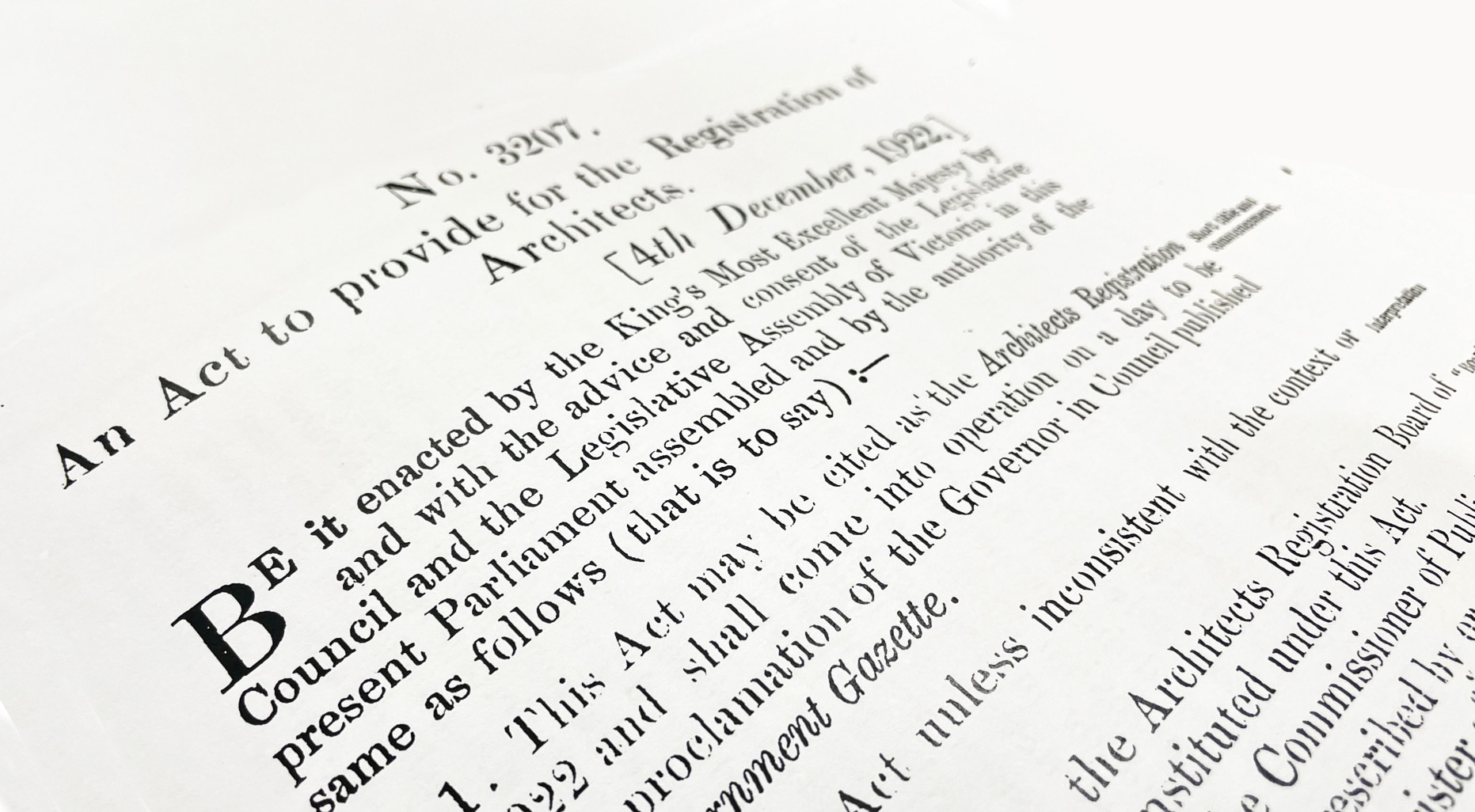The history of registration of architects in Victoria starts much earlier than the passing of its first Act in 1922. The first bill on the matter was drafted for the Victorian Parliament in 1890, and multiple bills were drafted (1890, 1915) and introduced (1892, 1918, 1919, 1920, 1921) over a thirty-year period before the first Act was passed. But the first consideration of the matter by the RVIA came in October 1887, just as a bill protecting dentists was being debated in the Victorian Parliament (enacted December 1887). By 1889, a registration bill for architects had been introduced into the South Australian parliament; concurrently, an architects’ registration bill was presented to the British Houses of Parliament. Both were defeated.
As a profession, architecture in the nineteenth century did not have distinct boundaries. Architecture, engineering and surveying were seen as correlated and, sometimes, interchangeable; and professionals working in those realms usually had capabilities across all three domains. Individuals could re-orient their professional skills depending on their circumstances and opportunities, and many offered multiple services. Masons, carpenters and builders would also, at times, rebrand themselves as architects as experience and opportunity came their way. Through the second half of the nineteenth century, professional societies had done much to help define the built environment disciplines, and they saw the pursuit of statutory regulation of the profession as a further crucial step.
The premise of these proposals were relatively simple: that the title of architect be restricted to those registered under the Act; that the registration process be overseen by a council or board consisting of nominees from the Royal Victorian Institute of Architects (RVIA), architects or practitioners, architectural education and Governor-in-Council (government); and that the registrants be able to demonstrate their fitness through relevant experience, education, examination or a combination thereof.
Earlier iterations of the draft bills also sought to restrict the practise of architecture to those registered, by limiting the capacity to charge for professional services as an architect solely to registrants – the draft and bill of the 1890s and the 1915 draft included these stipulations, but these clauses were dropped for the bills that appeared from 1918 onwards. Unsurprisingly, restrictions on the right to charge fees for some services (for instance, iterations in the 1890s included building surveying) soon brought the umbrage of related professions. The 1892 bill included clauses protecting the rights of engineers to continue to practise and supervise construction; this protection was extended to surveyors in the 1915 draft; and naval architects in the 1918 bill. For good measure, representatives from the professional bodies representing engineers and surveyors in Victoria were included as nominated members of the Registration Board in the bills introduced from 1918.
The long gap between drafted bills in Victoria from 1892 to 1915 belied the level of interest from the profession in achieving registration. The financial crash of 1892 was a serious blow to the profession, from which it took more than five years to recover. In 1897, the US State of Illinois became the first place in the world to enact registration for architects, soon followed by California (1901) and New Jersey (1902). In the United Kingdom, the topic of architectural registration – first introduced to the British Parliament in the 1888-89 session, albeit unsuccessfully – had been the subject of rancorous debates throughout the 1890s, where opposing sides argued whether architecture, as an art, could be defined and circumscribed in this way. In Western Australia, a registration bill was introduced in 1897 but similarly defeated. By 1906, the topic was again under serious consideration by the Victorian profession and the Institute anticipated it would soon go before parliament (it didn’t). The discussion was also active in Sydney, and in 1910, the Institute of Architects of New South Wales (IANSW) approached the Victorians with a view to lobbying for a federal bill on the registration of architects, but the idea failed to garner support from every state and the proposal languished. By 1911, the RVIA was waiting to see how efforts in other states would fare. In 1913, the IANSW asked the RVIA to hold back on a bill, confident their own efforts would pass and provide a precedent for Victoria to follow. Again, the efforts came to nought. But these actions galvanised the RVIA, and by 1915 they had drafted the new bill for consideration.
By this stage, the RVIA were in active discussions with the Minister for Public Works, Frederick Hagelthorn, and had received assurances that their bill would be presented. But when the bill was finally read for the first time in 1918, it was introduced by AA Billson, the member for Ovens. Billson had a personal connection to architecture: his son, Edward Fielder Billson, was the first graduate of the Diploma of Architecture at the University of Melbourne in 1915. Billson was nothing if not persistent, introducing the bill in three consecutive years (1918, 1919, 1920). Oddly, a second bill was introduced in 1920 – the key difference being that protected title was ‘registered architect’, rather than ‘architect’ – by the then-Minister for Public Works, Frank Clarke. The two bills remained under concurrent consideration into 1921, receiving various readings in the upper and lower houses. Finally, in 1922, Architects’ Registration Bill (No. 2) was passed, the field cleared as Billson had not revived No. 1 for further consideration. The Architects’ Registration Act (1922) had taken some thirty-five years of discussion, lobbying and debate to be achieved, and even then, with the compromise of protecting only ‘registered architects’.
As with any legislation, the Act received periodic adjustment. Minor changes were enacted in 1927 and 1928 that curtailed the eligibility of architects who had been in practise for a specified period of time (initially, in bona fide practise for a minimum of one year), instead requiring that they either held a degree, diploma or certificate in architecture, or had a required amount of experience and passed an examination. This signalled the end of a period of transition: where once professional activity alone sufficed as evidence of competency, now a formal qualification or an examination was required for registration. In 1939, an amendment finally brought registration of architects in Victoria into line with other Australian jurisdictions by protecting the title of ‘architect’ instead of ‘registered architect’.
In 1958, a new Act was passed that not only consolidated the changes since 1928 (including a 1953 amendment that dealt with the removal of a listed engineering body), but also required of all candidates, regardless of their training or education, a minimum of two years of practical experience. Technically, an architect who had completed four years of articles and the requisite practical experience could register under the 1958 Act; practically, this was increasingly difficult to achieve, with the Board preferring recognised qualifications in architecture.
A series of amendments in the 1970s reflected the changing nature of the profession. The 1970 amendment made provision for firms or incorporated bodies to be registered, so long as two-thirds of the directors were registered architects. A ten-year transition period was specified, requiring only half of the directors to be registered until its expiry in 1980. This was formalised in 1976, when the Act was amended to include a register of firms and corporations. The same amendment required the provision of regulations for professional conduct for the first time; in 1978 the Act was amended again to specify that the regulations for professional conduct would be published, as well as moving the jurisdiction of prosecutions under the Act to be in the purview of the ARBV, rather than the Magistrates’ Court.
There had been various concerns raised from the 1970s about the adequacy of the Architects’ Act. While seeing an increasing focus on the standards of professional conduct, the Board lacked capacity to publish findings or name architects found in breach of such; and while it was empowered to sit as a court of law, no appeal mechanisms existed. In 1986, the ARBV approached the Minister of Housing and Construction requesting a review of the Act, and the Board were then charged to make appropriate recommendations. The subsequent report weighed up the pros and cons of architectural registration. On the plus side, registration conferred distinction between the qualified professional and the unqualified practitioner; it was the basis for establishing, maintaining and prosecuting professional and ethical standards for the protection of the public, and these brought social and economic benefit through the ability to easily identify competent practitioners and the requirement to impartially administer building contracts. On the negative, architects did not have the same level of protection that some other professions enjoyed, but were bound by a strict code of ethics that did not apply to unregistered practitioners; and practise mobility between states was limited as each state had its own Act and registration requirements. The Board also proposed that architects already on the register should be subject to review and reassessment, and that compulsory continuing education should be required.
In 1989, a state government body, the Regulation Review Unit, released the ‘Occupational Regulation Review Discussion Paper No. 6: Review of Architects Regulation’. In short, the paper recommended that the Architects’ Act be repealed and the profession regulate itself, on the basis that the legislation had failed to respond to the changes to architectural education, increased consumer protections, and improvements to building regulations. In other words, the reasons why registration of architects had been necessary sixty-five years earlier were mostly eliminated through other mechanisms – legal and educational – that had broader reach than the Architects’ Act. The paper dropped in December 1989, with submissions in response sought by mid-February 1990 – there is no doubt that some would have interpreted the timing (for an industry that then traditionally shut down over January) as deliberate. The profession, collectively, was aghast and quickly mobilised itself to counter the assertions and defend the need for architectural registration.
The response was largely focused on ensuring continuing consumer protections. Deregulation would mean the consumer could not distinguish those offering architectural services; degrees in architecture could come from any location worldwide and did not necessarily guarantee appropriate knowledge; the requirement for architect to be an expert who protected consumer interests would disappear and there would not be means of managing conflicts of interest (such as working in league with builders to the detriment of the client); and architects would not be able to export their services elsewhere. The submissions argued that the practise of architecture was already deregulated – consumers already had a choice whether they employed an architect or not. Many of the arguments for and against closely echoed the ones that had accompanied considerations of architectural registration from the late nineteenth century and into the twentieth. These were that registration created a cartel, was of benefit only to architects, and was unnecessary, versus registration offering better consumer protection and thus better outcomes for all.
The final report from the RRU was substantially different to the Discussion Paper No. 6. It recommended retaining registration and, in a back-to-the-future moment, protecting the title ‘registered architect’. When the new bill was presented to State Parliament in 1991, it placed more emphasis on consumer protection, with requirements for professional indemnity insurance and review provisions through the Administrative Appeals Tribunal, but otherwise remained largely aligned with the earlier iterations of the Act – including the protection of the term ‘architect’. Some anomalies were addressed: candidates no longer needed to have reached the age of 21 years; and the educational institutions offering degrees in architecture were no longer specified. Finally, at long last, articled training was removed as a qualifying option, some fifty years after it had effectively disappeared as viable training for aspiring architects.
Subsequent changes to the Architects’ Act 1991 have largely been a process of updating terminology, entity names, responsible agencies and linked legislation. Although the 1991 Act had removed the exceptions for naval architects, amendments in 2004 reinstated them, as well as adding landscape architects and computer systems architects. The Act continues to be influenced by external provisions. For instance, the Commonwealth Mutual Recognition Act of 1992 has meant that architects registered in one state looking to operate in another are automatically deemed to be registered in the new location (with the exception of Queensland, that has not participated in the automatic recognition scheme), thus eliminating former difficulties of managing interstate architectural practice. A definition of mutual recognition was included in the Architects’ Act (1991) in 2023. Important clauses on probity issues were incorporated in amendments of 2020 that detailed a series of considerations to determine whether a candidate was a fit and proper person for registration.
Even though the context in which the Architects’ Act has operated has changed considerably over the last hundred years, the arguments for its existence have remained remarkably consistent and compelling. Indeed, in recent years, the tide has turned away from a push for deregulation towards greater regulation and to encompass possible registration for larger sections of the built environment trades and professions, including all those involved in the design of buildings. The relative simplicity of the Architects’ Act, from its inception, has meant it has remained relevant and robust, supporting consumer confidence in the professional standards of those registered as architects.
Prepared by Professor Julie Willis of the University of Melbourne
Updated


